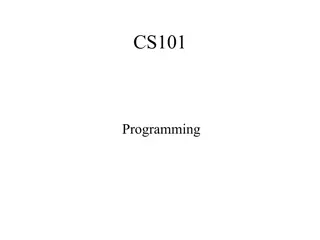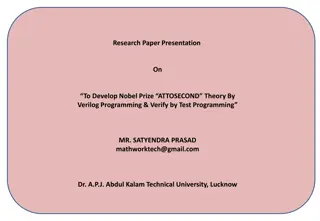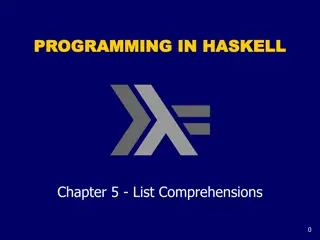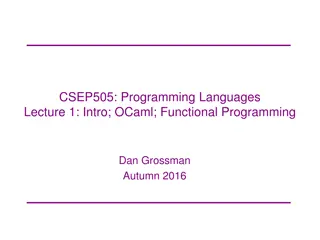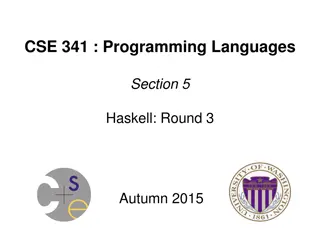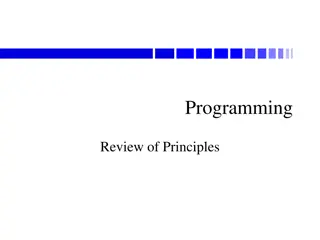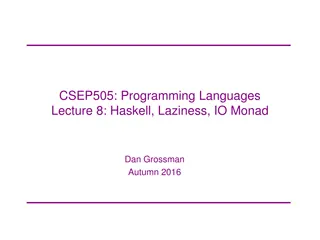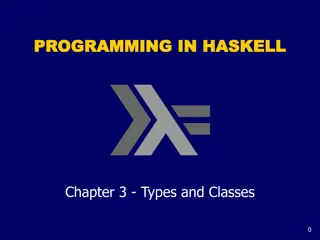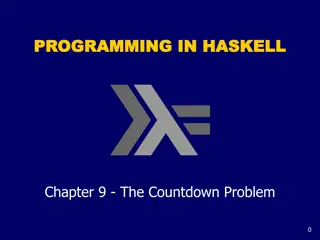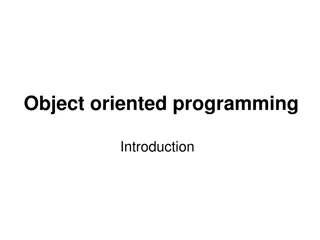PROGRAMMING IN HASKELL
Defined recursively, Haskell functions like factorial and product can be expressed elegantly. Discover the power of recursion for defining and proving properties of various functions.
Download Presentation

Please find below an Image/Link to download the presentation.
The content on the website is provided AS IS for your information and personal use only. It may not be sold, licensed, or shared on other websites without obtaining consent from the author.If you encounter any issues during the download, it is possible that the publisher has removed the file from their server.
You are allowed to download the files provided on this website for personal or commercial use, subject to the condition that they are used lawfully. All files are the property of their respective owners.
The content on the website is provided AS IS for your information and personal use only. It may not be sold, licensed, or shared on other websites without obtaining consent from the author.
E N D
Presentation Transcript
PROGRAMMING IN HASKELL PROGRAMMING IN HASKELL Chapter 6 - Recursive Functions 0
Introduction As we have seen, many functions can naturally be defined in terms of other functions. fac :: Int Int fac n = product [1..n] fac maps any integer n to the product of the integers between 1 and n. 1
Expressions are evaluated by a stepwise process of applying functions to their arguments. For example: fac 4 = product [1..4] = product [1,2,3,4] = 1*2*3*4 = 24 2
Recursive Functions In Haskell, functions can also be defined in terms of themselves. Such functions are called recursive. fac 0 = 1 fac n = n * fac (n-1) fac maps 0 to 1, and any other integer to the product of itself and the factorial of its predecessor. 3
For example: fac 3 = 3 * fac 2 = 3 * (2 * fac 1) = 3 * (2 * (1 * fac 0)) = 3 * (2 * (1 * 1)) = 3 * (2 * 1) = 3 * 2 = 6 4
Note: z fac 0 = 1 is appropriate because 1 is the identity for multiplication: 1*x = x = x*1. z The recursive definition diverges on integers 0 because the base case is never reached: > fac (-1) *** Exception: stack overflow 5
Why is Recursion Useful? z Some functions, such as factorial, are simpler to define in terms of other functions. z As we shall see, however, many functions can naturally be defined in terms of themselves. z Properties of functions defined using recursion can be proved using the simple but powerful mathematical technique of induction. 6
Recursion on Lists Recursion is not restricted to numbers, but can also be used to define functions on lists. product :: Num a [a] a product [] = 1 product (n:ns) = n * product ns product maps the empty list to 1, and any non-empty list to its head multiplied by the product of its tail. 7
For example: product [2,3,4] = 2 * product [3,4] = 2 * (3 * product [4]) = 2 * (3 * (4 * product [])) = 2 * (3 * (4 * 1)) = 24 8
Using the same pattern of recursion as in product we can define the length function on lists. length :: [a] Int length [] = 0 length (_:xs) = 1 + length xs length maps the empty list to 0, and any non-empty list to the successor of the length of its tail. 9
For example: length [1,2,3] = 1 + length [2,3] = 1 + (1 + length [3]) = 1 + (1 + (1 + length [])) = 1 + (1 + (1 + 0)) = 3 10
Using a similar pattern of recursion we can define the reverse function on lists. reverse :: [a] [a] reverse [] = [] reverse (x:xs) = reverse xs ++ [x] reverse maps the empty list to the empty list, and any non-empty list to the reverse of its tail appended to its head. 11
For example: reverse [1,2,3] = reverse [2,3] ++ [1] = (reverse [3] ++ [2]) ++ [1] = ((reverse [] ++ [3]) ++ [2]) ++ [1] = (([] ++ [3]) ++ [2]) ++ [1] = [3,2,1] 12
Multiple Arguments Functions with more than one argument can also be defined using recursion. For example: z Zipping the elements of two lists: zip :: [a] [b] [(a,b)] zip [] _ = [] zip _ [] = [] zip (x:xs) (y:ys) = (x,y) : zip xs ys 13
z Remove the first n elements from a list: drop :: Int [a] [a] drop 0 xs = xs drop _ [] = [] drop n (_:xs) = drop (n-1) xs z Appending two lists: (++) :: [a] [a] [a] [] ++ ys = ys (x:xs) ++ ys = x : (xs ++ ys) 14
Quicksort The quicksort algorithm for sorting a list of values can be specified by the following two rules: z The empty list is already sorted; z Non-empty lists can be sorted by sorting the tail values the head, sorting the tail values the head, and then appending the resulting lists on either side of the head value. 15
Using recursion, this specification can be translated directly into an implementation: qsort :: Ord a [a] [a] qsort [] = [] qsort (x:xs) = qsort smaller ++ [x] ++ qsort larger where smaller = [a | a xs, a x] larger = [b | b xs, b x] Note: z This is probably the simplest implementation of quicksort in any programming language! 16
For example (abbreviating qsort as q): q [3,2,4,1,5] q [2,1] ++ [3] ++ q [4,5] q [1] ++ [2] ++ q [] q [] ++ [4] ++ q [5] [] [1] [] [5] 17
Exercises (1) Without looking at the standard prelude, define the following library functions using recursion: z Decide if all logical values in a list are true: and :: [Bool] Bool z Concatenate a list of lists: concat :: [[a]] [a] 18
z Produce a list with n identical elements: replicate :: Int a [a] z Select the nth element of a list: (!!) :: [a] Int a z Decide if a value is an element of a list: elem :: Eq a a [a] Bool 19
(2) Define a recursive function merge :: Ord a [a] [a] [a] that merges two sorted lists of values to give a single sorted list. For example: > merge [2,5,6] [1,3,4] [1,2,3,4,5,6] 20
(3) Define a recursive function msort :: Ord a [a] [a] that implements merge sort, which can be specified by the following two rules: z Lists of length 1 are already sorted; z Other lists can be sorted by sorting the two halves and merging the resulting lists. 21





